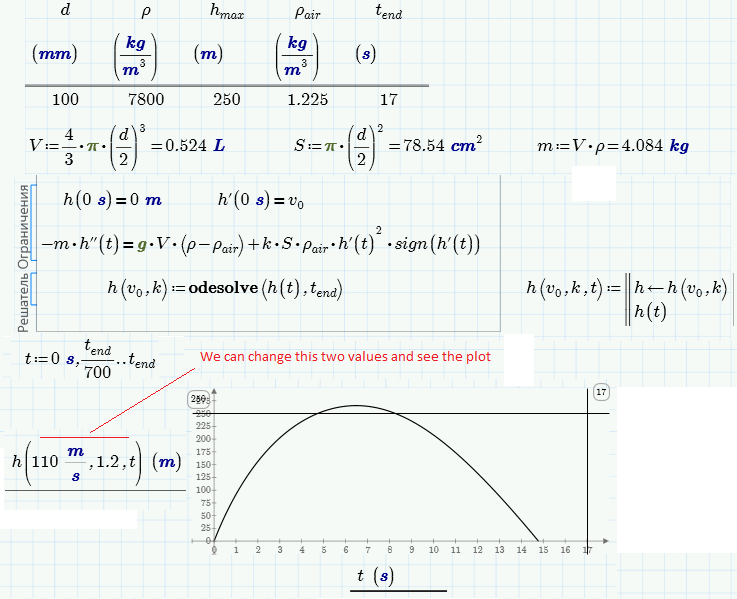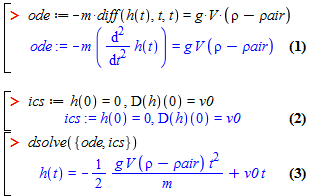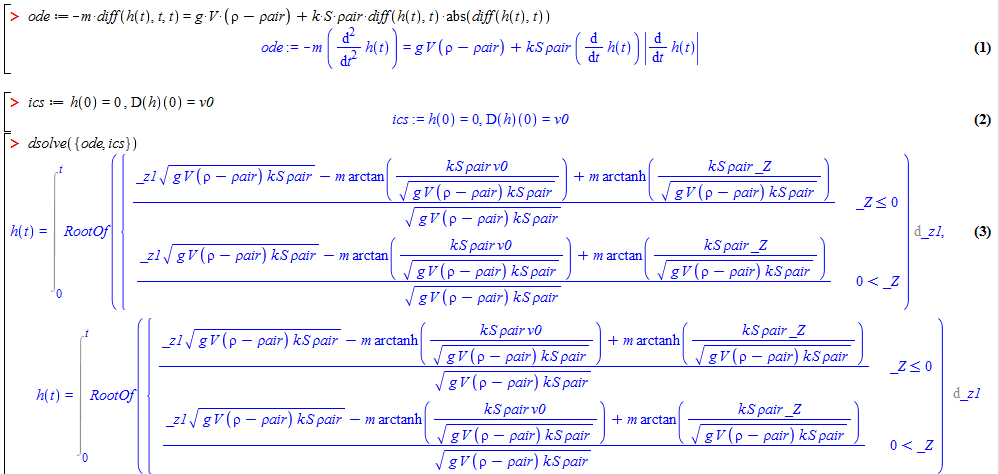- Subscribe to RSS Feed
- Mark Topic as New
- Mark Topic as Read
- Float this Topic for Current User
- Bookmark
- Subscribe
- Mute
- Printer Friendly Page
New ode problem
- Mark as New
- Bookmark
- Subscribe
- Mute
- Subscribe to RSS Feed
- Permalink
- Notify Moderator
New ode problem
New ode problem (for Alan, Viktor and all):
A steel ball (with d=100 mm and Ro=7800 kg/m^3) was thrown upward. He has reached a certain maximum height (h.max=250 m) and fell to the ground after a certain time (t.end=17s).
What is the initial speed of the ball and what is a value of the coefficient of drag k (F.drag=k S Ro.air v^2). Ro.air=1.225 kg/m^3 or is a function of the height.
See for the start here http://communities.ptc.com/message/187832
Solved! Go to Solution.
- Labels:
-
Calculus_Derivatives
Accepted Solutions
- Mark as New
- Bookmark
- Subscribe
- Mute
- Subscribe to RSS Feed
- Permalink
- Notify Moderator
Thanks, Alan!
I would like to use the Maximize function but:

PS
Better to have:

- Mark as New
- Bookmark
- Subscribe
- Mute
- Subscribe to RSS Feed
- Permalink
- Notify Moderator
Please, Valery. Sorry, without units (MC 14).
Viktor
- Mark as New
- Bookmark
- Subscribe
- Mute
- Subscribe to RSS Feed
- Permalink
- Notify Moderator
Thanks and Sorry,
not v(t)^2 but v(t)*|v(t)| or v(t)^2*sign(v(t))
And attach please the file!
- Mark as New
- Bookmark
- Subscribe
- Mute
- Subscribe to RSS Feed
- Permalink
- Notify Moderator
What is it with you and throwing balls in the air Valery!!! ![]()
Oh well, attached is my version - in Prime 2, with units.
Alan
- Mark as New
- Bookmark
- Subscribe
- Mute
- Subscribe to RSS Feed
- Permalink
- Notify Moderator
Alan, show a picture please. I do not have MC Prime now!
Viktor
- Mark as New
- Bookmark
- Subscribe
- Mute
- Subscribe to RSS Feed
- Permalink
- Notify Moderator
Actually, my 'solution' is wrong! I made an incorrect assumption. For some reason I'm unable to edit my earlier post! But I can edit this one!!!
I'll try to generate a correct solution later today, and will post a picture of it as well Viktor.
Alan
- Mark as New
- Bookmark
- Subscribe
- Mute
- Subscribe to RSS Feed
- Permalink
- Notify Moderator
Up and down phases are symmetrical only by k=0!
- Mark as New
- Bookmark
- Subscribe
- Mute
- Subscribe to RSS Feed
- Permalink
- Notify Moderator
1) How to do it automatically (see the picture, Mathcad 15 and Mathcad Prime files)?
2) Has the problem solution by this initial data?

- Mark as New
- Bookmark
- Subscribe
- Mute
- Subscribe to RSS Feed
- Permalink
- Notify Moderator
Here's my automatic answer. Of course the up and down movements are not symmetrical, as I had assumed in my first post, because of the drag! I've not bothered with the Archimedes upthrust as it's a small effect.
Alan
Here are the images, for Viktor:
v0 seems very high!
- Mark as New
- Bookmark
- Subscribe
- Mute
- Subscribe to RSS Feed
- Permalink
- Notify Moderator
Thanks, Alan!
I would like to use the Maximize function but:

PS
Better to have:

- Mark as New
- Bookmark
- Subscribe
- Mute
- Subscribe to RSS Feed
- Permalink
- Notify Moderator
Yes, tend = 15s gives smaller v0 and k. The system is very sensitive to tend, and, as it stands fails for tend of 14s or less. Can you determine (automatically) the minimum value of tend for which the program will find a solution?
Alan
- Mark as New
- Bookmark
- Subscribe
- Mute
- Subscribe to RSS Feed
- Permalink
- Notify Moderator
We can carry out real experiment - shoot guns or catapults cannon ball straight up and measure the time of flight and maximum lift of the cannon ball!
Ro=f(h)
- Mark as New
- Bookmark
- Subscribe
- Mute
- Subscribe to RSS Feed
- Permalink
- Notify Moderator
Valery Ochkov wrote:
We can carry out real experiment - shoot guns or catapults cannon ball straight up and measure the time of flight and maximum lift of the cannon ball!
Ro=f(h)
Expensive method!
In terms of the model, the minimum possible time that doesn't lead to a failure to converge, is when k is zero. This gives a tend of 2.sqrt(2.hmax/g).
Alan
- Mark as New
- Bookmark
- Subscribe
- Mute
- Subscribe to RSS Feed
- Permalink
- Notify Moderator
AlanStevens wrote:
Valery Ochkov wrote:
We can carry out real experiment - shoot guns or catapults cannon ball straight up and measure the time of flight and maximum lift of the cannon ball!
Ro=f(h)
Expensive method!
Alan
But I have in Moscow Kremlin one device for this experiment:

- Mark as New
- Bookmark
- Subscribe
- Mute
- Subscribe to RSS Feed
- Permalink
- Notify Moderator
A symbolic solution of the problem (Maple):
a) k=0

b) k>0






